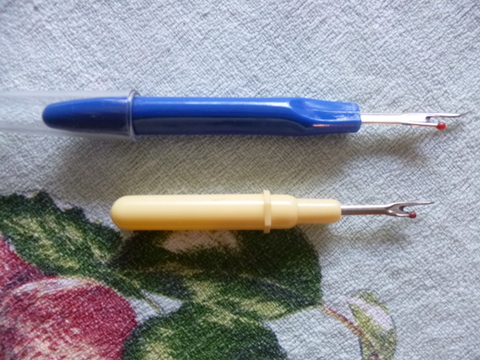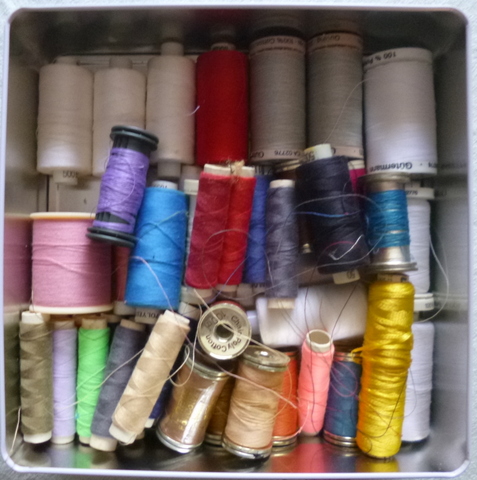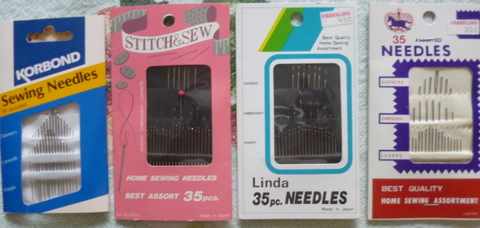In any major breakdown the supply of industrial products such as textiles will start drying up as soon as there is no electricity to run the machines, no fuel to allow distribution and no money to pay for imports. The obvious way around this is to have a supply of cloth put away or better yet be in a position to produce your own eg homespun wool. The first step on this road, however , is having the gear and the knowledge to repair the clothes that you already own so that you can increase their effective life and buy time so you can tool up for home production.
Let’s face it even in normal times the ability to keep your clothes in repair, while not being a life or death issue, can save you money and reduce your reliance on the system. The following section gives suggestions for a basic clothes repair kit for the person on their own, a family kit for more advanced sewers and a portable kit for the pack or suitcase.
THE BASIC KIT
- Hand Sewing Needles - For clothing repair and general sewing the variety known as sharps are most commonly used, an assortment of sizes being handy to have. There are packets of assorted sizes of sharps, darners and embroidery needles that are available at ridiculously cheap prices from our supermarket chains. It is worth stocking away far more needles than you will ever need as they are cheap, easy to store and durable and they make almost the perfect trade good.
- Pins - The standard 25mm long dressmakers pins are ideal for clothing repair, nickel plated steel is the most common material of construction and is sufficient for most jobs but stainless steel is better because it will not rust and will last longer in use. Some plastic headed pins are also worth having because they are easy to see and comfortable to work with. Keep a good supply on hand because pins that become dull with use may damage or snag fabric and so should be discarded.
- Safety Pins - While they should not be used for permanent repairs having a selection various sizes of safety pins in the mending kit will allow emergency repairs to be carried out quickly and efficiently.
- Thread - Polyester thread can be used on most fabrics and so is the best for clothing repair. Five colours will cover most repair jobs: black (or dark brown or blue), white, red, a medium grey or tan shade and some transparent monofilament thread that allows repairs to be carried out on any colour fabric. A 500 metre spool of each is a good start but while thread is cheap and readily available it is worth stocking up on black and white and having at least one spool each of the more common colours. A good idea also is to have a card or two of waxed linen thread for heavy duty clothing repairs and repairs to thick cloth such as canvas, it is available from saddleries and hardware shops.
- Thimble - This is used to protect the middle finger while hand sewing, they come in several sizes to ensure a snug fit so make sure you get one that fits you.
- Needle Threader - This is a loop of thin wire fixed to an easily grasped handle, the wire is pushed through the eye of the needle and the thread inserted in the loop thus formed. When the loop is pulled back through the eye the thread is pulled with it, threading the needle. This can be extremely handy if the lighting is poor, you can't find your glasses or you're trying to fix a rip in your trousers with cold wet hands.
- Seam Ripper - This useful little tool makes it easy to remove stitching, cut seams open and rip hem, the pointed end then being used to remove the cut stitches.
- Scissors - Buy the best quality scissors that you can even if you have to mortgage your spouse to do it! They should last a lifetime if treated with care and used for sewing only. A small oilstone should also be bought to keep them sharp or get the Wiltshire Staysharp type and a spare sharpening cartridge. Six inches (15 cm) is a good length and they should have one sharp point for clipping, snipping and trimming.
- Sewing Gauge - This is a 15 cm ruler with a sliding marker used for making small measurements and keeping distances constant while marking hems, button locations and pleats etc.
- Glue Stick - Can be used to form a temporary bond for hems, trims, appliques and zippers so that pinning or basting is unnecessary.
- Liquid Fray Preventer - (eg Fray Stop) A colourless solvent based liquid polymer solution that prevents fraying and unravelling along the cut edge of a fabric. It can also be used to control ladders in panty hose and tidy up buttonholes that have become frayed.
- Beeswax - Hand sewing thread is run across this to apply a waxy lubricating film to cut down on knotting and tangling. It is usually sold in a container with slots in it for this purpose but a white candle stub can also be used and is just as good.
- Buttons - It is well worth keeping a jar of assorted old buttons for replacing ones that go astray. If you do not regularly cannibalise worn out clothing for their buttons the prime source of supply at a reasonable price is the local Opportunity Shop. A supply of recycled buttons can also be worth their weight in gold by keeping the kids out from under your feet on a wet afternoon!
- Hooks, Eyes & Snaps - Keep a varied supply of these on hand in nickel for light fabrics and black finish for dark fabrics.
THE FAMILY KIT
This contains everything in the basic kit as well as the following additional items:
- Dressmakers Shears - These shears have longer blades and larger handles than the scissors and so are more comfortable to use for long cuts. They are used for, among other things, cutting excess fabric from hems and seams.
- Tape Measure - 150 cm (60") is the ideal length for a tape measure and it should be made of flexible plastic or fibreglass that won't stretch. It should have protective metal tips on both ends and have measurements on both sides. It is used for body and garment measurements.
- Yard (metre?) Stick or Skirt Marker - A skirt marker is a ruler that stands up on a base and has a sliding marker allowing chalk or pins to mark the distance from the floor accurately to ensure even hems.
- Tailors chalk - Comes as wedges in a special holder or in the form of a pencil, various pastel shades are available. They are used for marking fitting alterations, pleats, buttonholes etc.
- Elastic - Comes in various widths but 6mm ribbed elastic is probably the most all purpose. It can be used to resuscitate saggy underwear, shorts, tracksuit cuffs and ankles or anywhere your elastic lets you down.
- Fusible Web - This is a nonwoven bonding agent available in strips and sheets, to use the web it is cut to size, placed between two layers of fabric and then melted by running a hot steam iron over the area, this bonds the two layers of fabric. It can be used to hold a hem, trim, facing or material patch in place without sewing. Fusible web should not be used on some synthetics so read the instructions on the pack carefully and test on a scrap of material if possible first.
- Iron-on Patches and Appliques - Used in a similar way to fusible web but usually applied to the outside of the garment to cover rents, tears and holes. Iron-on appliques are an easy and attractive way of repairing holes and tears in children's clothing.
- Steam and Dry Iron - When used to apply the two items above, the iron becomes a tool for clothing repair. Fusibles require water to bond properly so a steam iron should be used in conjunction with a damp press cloth.
- Press Cloth - A lint free press cloth should be used when applying fusibles and when pressing on the right side of the fabric.
- Table Top Ironing Board - Can be set up on a table to make small pressing jobs easier.
- Portable Sewing Machine - This battery powered little wonder is often seen for sale cheaply through mail order suppliers. It can be used to hem skirts and slacks, repair rips and sew on patches.
THE TRAVELLERS KIT
Into a small box or tin pack the following:
- A small pack of hand sewing needles,
- A good length of each of the five repair thread colours from the basic kit above, wrapped around a length of cardboard,
- A needle threader to be used for repairing knit snags,
- A glue stick for emergency tacking,
- A selection of buttons,
- Half dozen to a dozen safety pins of varying sizes,
- A pair of folding scissors,
- A thimble.
All of the materials above can be purchased from specialised sewing shops that are located in many of the large shopping centres around Australia, but a surprising number can also be bought at the supermarket. To build up a reasonable clothing repair kit only requires the addition of a packet of needles or pins here and a spool of thread there to the family shopping cart while doing the grocery shopping. This allows the kit to be built up slowly and painlessly until the larger and more specialised items are required and before you know it you will have your own comprehensive clothing first aid kit.






